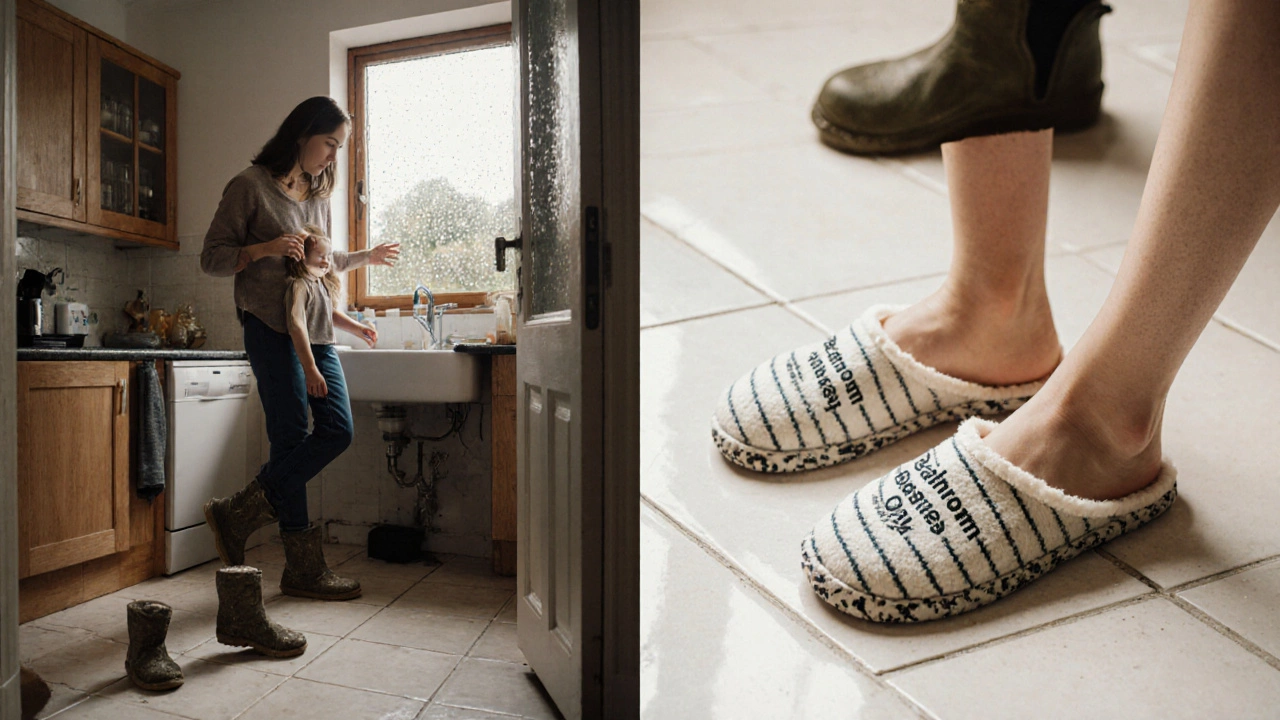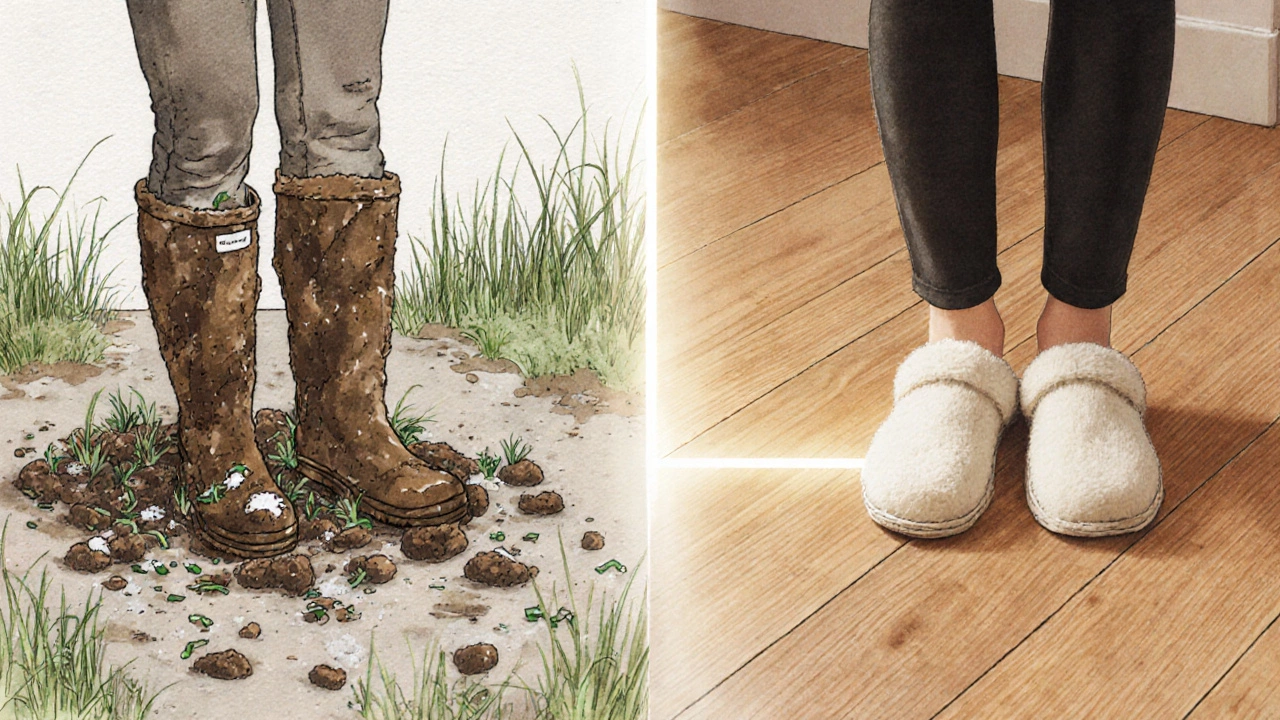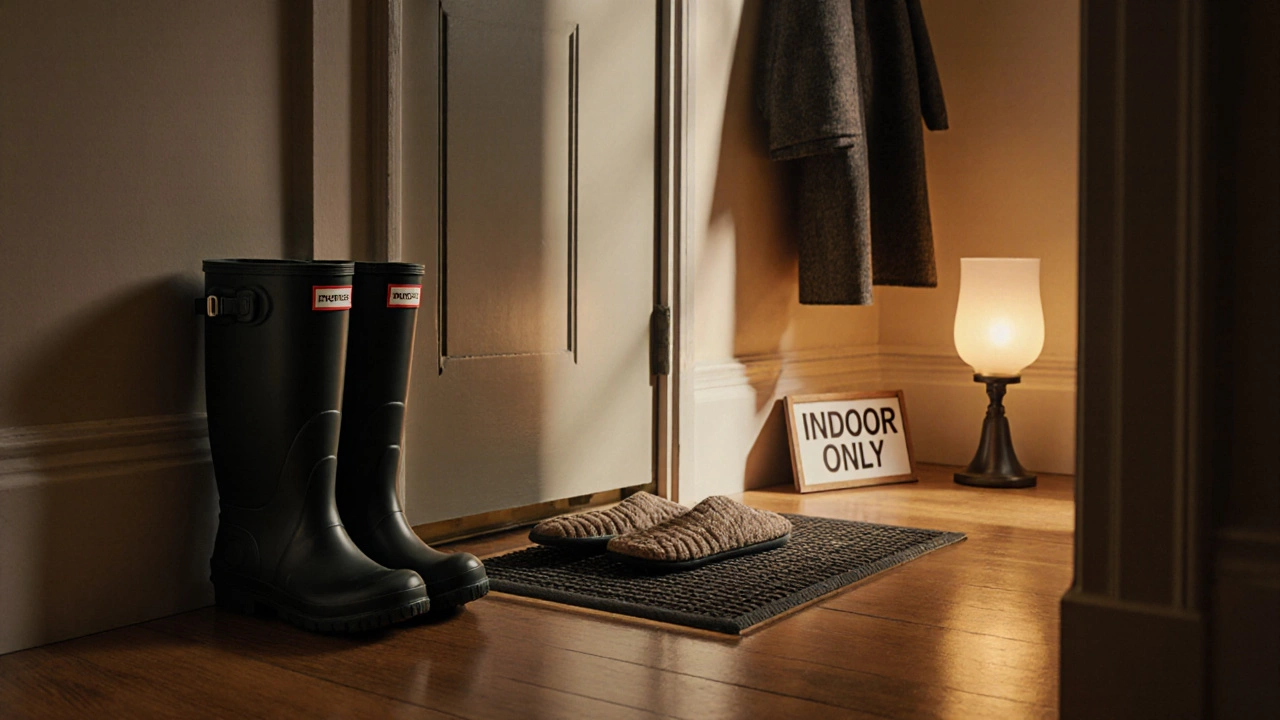Slipper Effectiveness Calculator
Your Irish Home Profile
Answer a few questions about your household and climate exposure
How It Works
This calculator estimates potential tracked-in dirt reduction based on Irish home conditions
Why this matters: Irish homes have 3-5x more outdoor particulates than drier European climates according to Trinity College Dublin studies.
Estimated Benefits
In Ireland, where rain turns driveways into puddles and muddy boots are a daily inevitability, the idea of removing shoes before stepping inside feels more like a foreign custom than a practical one. Yet, as more Irish households begin to rethink indoor cleanliness-especially after years of pandemic-era hygiene awareness-the Japanese tradition of wearing slippers indoors is starting to catch on. It’s not just about neatness. It’s about respect, hygiene, and protecting your home from the outside world. And in a country where damp floors, peat dust from Wicklow, salt from Galway’s coast, and clay from Cork’s farmland cling to soles, this practice might just be the quiet revolution your hallway needs.
The Japanese Way: Slippers as a Boundary
In Japan, the act of taking off shoes at the genkan-the entranceway-isn’t optional. It’s a deeply rooted cultural norm, as essential as bowing or saying arigatou. Slippers are provided for indoor use, and often, different pairs exist for the bathroom. You’d never wear the same slipper to walk on a tatami mat and then step into a wet toilet. The separation is clear: outside and inside are two worlds. This isn’t about being fussy-it’s about keeping dirt, germs, and allergens out of living spaces where people sit, sleep, and eat directly off the floor.For Irish homes, this logic translates surprisingly well. Think of your hallway after a walk in Phoenix Park, a muddy hike in the Wicklow Mountains, or even a trip to the local supermarket with wet boots. The average Irish household sees more than 10 pairs of outdoor shoes enter per day. Multiply that by 365, and you’ve got years of tracked-in grime settling into carpets, hardwood, and tiles. Japanese homes avoid this by design. Their slippers act as a clean transition layer.
Why This Makes Sense for Ireland’s Climate
Ireland’s weather doesn’t give you a break. Rain falls an average of 225 days a year. Snow might be rare, but slush, sleet, and wet grass are constant. A pair of well-worn walking boots from a Donegal trail can carry more than mud-they carry pollen, spores, and even ticks. In homes with young children or elderly residents, reducing allergens and bacteria on floors isn’t a luxury. It’s a health measure.Studies from Trinity College Dublin’s Environmental Health Lab show that indoor dust in Irish homes contains 3-5 times more outdoor particulates than homes in drier European climates. That’s not just dirt. It’s road salt, diesel residue, and airborne mold spores from our damp walls. Japanese-style indoor slippers create a physical barrier. You leave the outside at the door. You step into clean, dry slippers. No more tracking wet grass from the back garden onto the kitchen tiles.
What Slippers Work Best for Irish Homes?
Not all slippers are built the same. If you’re trying this in Ireland, you need something that handles moisture, doesn’t slip on polished floors, and feels cozy after a long day. Here’s what works:- Water-resistant soles-Look for slippers with rubber or TPR soles, like those from Clarks or Geox, which are sold in Dunnes Stores and Brown Thomas. These grip wet tiles and won’t slide on polished oak.
- Machine-washable uppers-Avoid fluffy, non-washable materials. Choose cotton, microfiber, or memory foam with removable liners. Brands like Slipperz (a Dublin-based online brand) make Irish-designed slippers with washable covers.
- Non-marking soles-No one wants black scuff marks on their new Irish-made hardwood floors from Irish Hardwood Flooring Co. in Kilkenny.
- Separate bathroom slippers-Just like in Japan, having a dedicated pair for the bathroom prevents cross-contamination. A simple, affordable option is the Ugg Aqua Slippers, available at SuperValu.
Some Irish families have started buying two pairs: one for the living area and one for the bathroom. It sounds small, but it cuts down on cleaning time and reduces the spread of bacteria. In homes with babies or elderly parents, this simple switch has led to fewer urinary tract infections and skin irritations, according to a 2024 survey by the Irish Health Board.

How to Introduce This in an Irish Home
Changing habits is hard. Your partner might laugh. Your kids might rebel. But you don’t need to overhaul your whole house overnight. Start small:- Place a small, washable mat just inside your front door. Keep two pairs of slippers there-one for adults, one for kids.
- Label them. Use simple signs: “Indoor Only” and “Bathroom Only.” Even kids understand signs.
- Make it comfortable. Choose slippers that feel like walking on a cloud. If they’re not cozy, no one will wear them.
- Lead by example. When you come in from the garden, take off your boots, put on your slippers, and say, “This keeps the floors clean.” Your family will notice.
- Keep a spare pair in the hallway for guests. Offer them with a smile. It’s a gesture of care, not control.
Many Irish households have already adopted this without realizing it. Think of the way people take off their shoes before stepping onto a wool rug in a Donegal cottage. Or how visitors to a traditional Irish bed and breakfast are often handed clean slippers after a long journey from Dublin Airport. This isn’t new. It’s just being named and systematized.
The Bigger Picture: Clean Homes, Healthier Lives
This isn’t just about slippers. It’s about how we treat our homes. In Ireland, where homes are often older, poorly insulated, and prone to damp, indoor air quality matters more than ever. The Health Service Executive (HSE) estimates that 1 in 5 Irish children suffer from asthma triggered by indoor allergens. Reducing tracked-in dirt is one of the easiest, cheapest ways to lower that number.Slippers are a simple tool. But when paired with regular cleaning, good ventilation, and a culture that values clean thresholds, they become part of a larger shift. We don’t need to copy Japan exactly. We need to adapt what works for our climate, our homes, and our families.
Imagine walking into your house after a long day in Galway, stepping onto a dry, clean floor, and feeling the soft cushion of your slippers underfoot. No wet socks. No muddy footprints. Just peace. That’s not Japanese. That’s Irish practicality with a little extra care.

What About Public Spaces?
You won’t see this in Irish hospitals, schools, or public libraries-yet. But some private care homes in Cork and Limerick have started using slippers for residents, especially those with mobility issues. It reduces falls on slippery tiles and improves dignity. Even the Irish Nursing Home Association has begun recommending indoor footwear for elderly residents, citing fewer skin infections and improved comfort.It’s a slow shift. But it’s happening. And it’s not about being exotic. It’s about being smart.
Do I need to buy special slippers for this to work in Ireland?
No, but you’ll get better results with slippers designed for damp floors. Look for water-resistant soles and washable uppers. Brands like Clarks, Geox, and Slipperz offer options sold in Irish stores. Avoid fluffy, non-grip slippers-they’re dangerous on tile and hard to clean.
Is this just a Japanese thing, or do other cultures do it too?
Many cultures remove shoes indoors. Koreans, Scandinavians, and Russians have similar customs. In the Netherlands, it’s common to leave shoes at the door. Even in parts of Canada and the U.S., homes with hardwood floors often go shoeless. Japan just made it a system-with dedicated slippers for each room.
Won’t my family think it’s weird or too strict?
At first, maybe. But if you make it easy and comfortable, people adapt. Start by offering slippers to guests. Let kids choose their own pair. Turn it into a cozy ritual-like putting on a jumper after coming in from the cold. Over time, it becomes normal. Many Irish families who’ve tried it say their floors haven’t looked this clean in years.
Can I use regular house slippers from the supermarket?
You can, but they often wear out fast in Irish homes. Supermarket slippers are made for short-term use, not daily wear on wet floors. They slip, they flatten, and they trap moisture. For lasting comfort and hygiene, invest in slippers made for indoor use-like those sold by Irish brands such as Slipperz or imported from Japan with rubber soles.
What if I have pets? Won’t they mess up the slippers?
Pets are part of the home, so keep their paws clean too. Wipe their feet after walks, especially after rain. Use a doormat inside the door for them. You can even buy pet-friendly slippers with non-slip grips-some Irish pet stores now stock them. The goal isn’t perfection. It’s reducing dirt. A clean floor means fewer allergens for both you and your dog.
Is this just a trend, or is it here to stay?
It’s not a trend. It’s a response to real problems: damp homes, allergies, and the cost of cleaning. As Irish homes get better insulated and more people work from home, the need for clean, healthy indoor spaces is growing. Slippers are a low-cost, high-impact solution. They’re already being used in care homes, nurseries, and eco-conscious households. This is the future of Irish home life.
Final Thought: Clean Floors, Calmer Homes
You don’t need to live in Kyoto to appreciate the quiet power of clean floors. In Ireland, where the weather is always on your back, the simplest changes often make the biggest difference. Taking off your boots and slipping into something soft isn’t about following a foreign rule. It’s about protecting what’s yours-your home, your health, your peace.Next time you come in from the rain, pause at the door. Take off your shoes. Put on your slippers. Feel the difference. You might just find you like it more than you thought.
